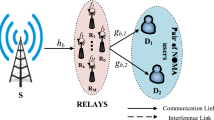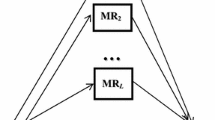Abstract
Due to mobile-to-mobile (M2M) communication unpredictability and difficulty in securing reliable channels, transmission of video over M2M networks is challenging. Cooperative communication and transmit antenna selection are two different techniques which can benefit from path diversity for robust video communication. In this paper, the outage probability (OP) performance of multi-relay-based M2M video transmission networks with transmit antenna selection over N-Nakagami fading channels is investigated. The exact closed-form expressions for OP of optimal and suboptimal TAS schemes are derived. The power allocation problem is formulated for performance optimization. Then the OP performance under different conditions is evaluated through numerical simulations to verify the analysis. The simulation results showed that the power-allocation parameter has a significant effect on the OP performance.







Similar content being viewed by others
References
Abdelnabi A, Fawaz AQ, Shaqfeh M, Ikki S, Alnuweiri H (2016) Performance analysis of MIMO multi-Hop system with TAS/MRC in Poisson field of interferers. IEEE Trans Commun 64(2):525–540
Elkashlan M, Yeoh P, Yang N, Duong T, Leung C (2012) A comparison of two MIMO relaying protocols in Nakagami-m fading. IEEE Trans Veh Technol 61(3):1416–1422
Gong FK, Ge J, Zhang N (2011) SER analysis of the mobile-relay-based M2M communication over double Nakagami-m fading channels. IEEE Commun Lett 15(1):34–36
Gong FK, Ye P, Wang Y, Zhang N (2012) Cooperative mobile-to-mobile communications over double Nakagami-m fading channels. IET Commun 6(18):3165–3175
Huo Y, El-Hajjar M, Hanzo L (2014) Wireless video: an interlayer error-protection-aided multilayer approach. IEEE Veh Technol Mag 9(3):104–112
Ilhan H, Uysal M, Altunbas I (2009) Cooperative diversity for intervehicular communication: performance analysis and optimization. IEEE Trans Veh Technol 58(7):3301–3310
Karagiannidis GK, Sagias NC, Mathiopoulos PT (2007) N*Nakagami: a novel stochastic model for cascaded fading channels. IEEE Trans Commun 55(8):1453–1458
Kumbhani B, Kshetrimayum R (2015) Analysis of TAS/MRC based MIMO systems over η − μ fading channels. IETE Tech Rev 32(4):62–62
Mumtaz S, Huq KMS, Rodriguez J (2014) Direct mobile-to-mobile communication: paradigm for 5G. IEEE Wirel Commun 21(5):14–23
Ochiai H, Mitran P, Tarokh V (2006) Variable-rate two-phase collaborative communication protocols for wireless networks. IEEE Trans Veh Technol 52(9):4299–4313
Salo J, Sallabi HE, Vainikainen P (2006) Statistical analysis of the multiple scattering radio channel. IEEE Trans Antennas Propag 54(11):3114–3124
Seyfi M, Muhaidat S, Liang J, Uysal M (2011) Relay selection in dual-hop vehicular networks. IEEE Signal Proc Lett 18(2):134–137
Shankar PM (2012) Diversity in cascaded in N*Nakagami fading channels. Ann Telecommun 68(7):477–483
Talha B, Patzold M (2011) Channel models for mobile-to-mobile cooperative communication systems: a state of the art review. IEEE Veh Technol Mag 6(2):33–43
Xu LW, Zhang H (2016) Performance analysis of threshold digital relaying M2M cooperative networks. Wirel Netw 22(5):1595–1603
Xu LW, Zhang H, Liu X, Gulliver TA (2015) Performance analysis of FAF relaying M2M cooperative networks over N-Nakagami fading channels. Int J Signal Proc Image Proc Pattern Recognit 8(5):249–258
Xu LW, Zhang H, Lu TT, Liu X, Wei ZQ (2015) Performance analysis of the mobile-relay-based M2M communication over N-Nakagami fading channels. J Appl Sci Eng 18(3):309–314
Xu LW, Zhang H, Lu TT, Gulliver TA (2015) Outage probability analysis of the VAF relaying M2M networks. Int J Hybrid Inf Technol 8(5):357–366
Xu LW, Zhang H, Wang JJ, Shi W, Gulliver TA (2015) End-to-end performance analysis of AF relaying M2M cooperative system. Int J Multimed Ubiquitous Eng 10(9):211–224
Xu LW, Zhang H, Gulliver TA (2015) Performance analysis of IDF relaying M2M cooperative networks over N-Nakagami fading channels. KSII Trans Internet Inf Syst 9(10):3983–4001
Acknowledgments
The authors would like to thank the referees and editors for providing very helpful comments and suggestions. This project was supported by National Natural Science Foundation of China (no. 61304222, no. 61301139), Shandong Province Outstanding Young Scientist Award Fund (no. 2014BSE28032).
Author information
Authors and Affiliations
Corresponding author
Rights and permissions
About this article
Cite this article
Xu, L., Gulliver, T.A. Performance analysis for M2M video transmission cooperative networks using transmit antenna selection. Multimed Tools Appl 76, 23891–23902 (2017). https://doi.org/10.1007/s11042-016-4138-z
Received:
Revised:
Accepted:
Published:
Issue Date:
DOI: https://doi.org/10.1007/s11042-016-4138-z




